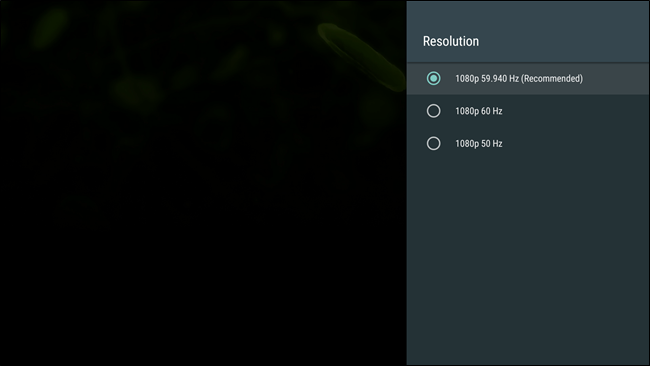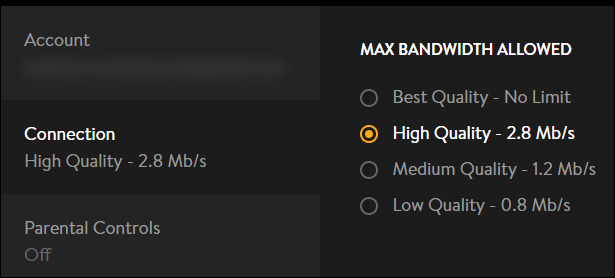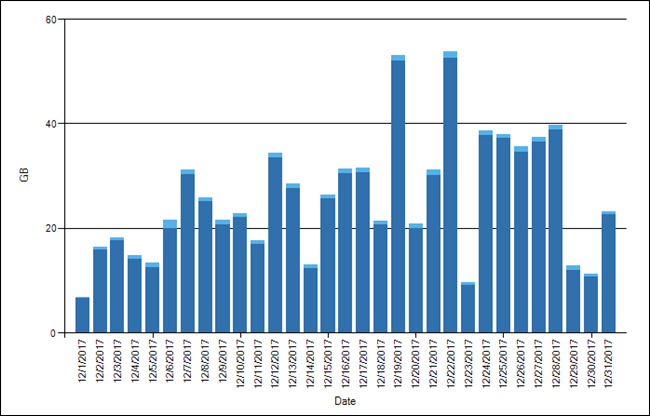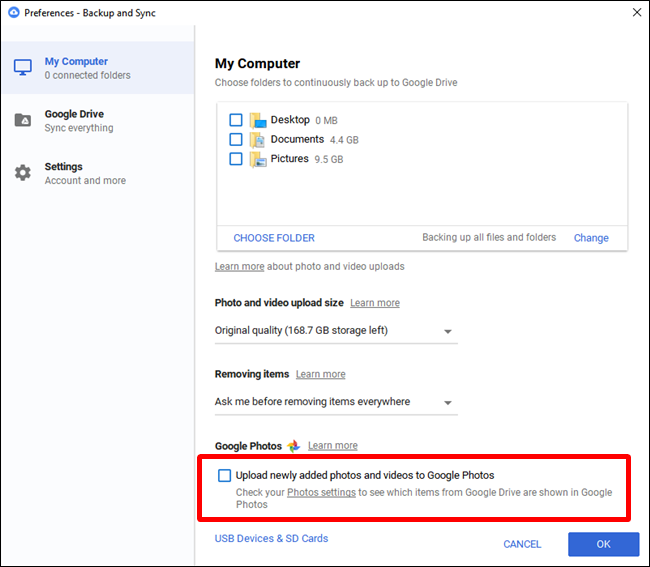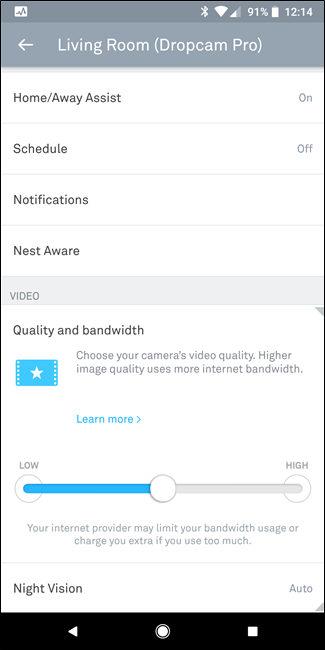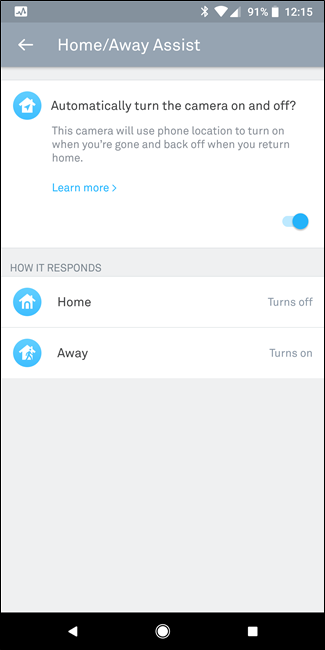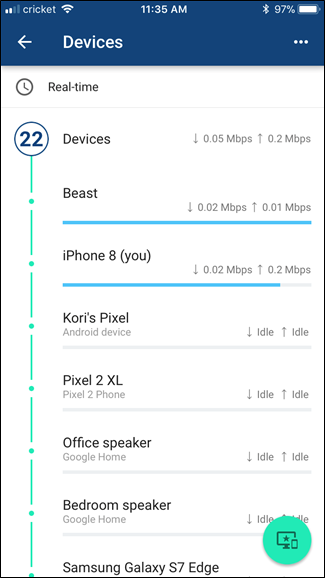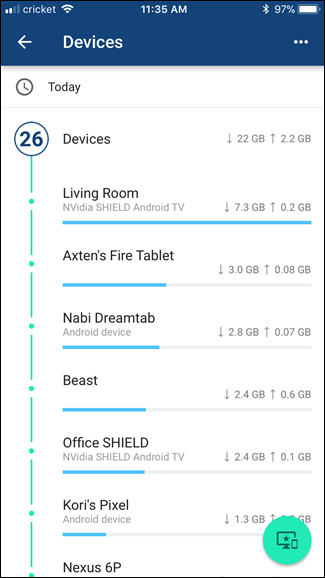Quick Links
It's not uncommon for internet service providers to cap the amount of data offered to home users as a way of getting them to pay more money for more bandwidth. If you find yourself within these artificial constraints set by your ISP, you have to carefully watch what you do online. Here are some tips to keep you under your cap and free from overage charges.
Understand What Uses Data
The first step to keeping your data usage in check is to understand what is using a lot of data and what isn't. For example, checking your email---if even if you check it four hundred times a day---isn't going to make a dent in a 1TB data package. But streaming videos over YouTube all day will, of course.
It's the gray area that I find confuses most people: Facebook, Instagram, and the like. And the issue here is that there isn't really a clear answer on what's "safe" and what isn't, because it's all defined by how you actually use these types of networks.
For example, if you scroll through Facebook and watch every video that auto-plays in your feed, guess what? You're likely going to chew through a reasonable amount of data doing so. The same goes for Instagram.
If, however, you keep auto-playing videos disabled and selectively pick and choose the content you want to watch, you'll likely save yourself a lot of unnecessarily used data. That said, if you're a heavy Facebook or Instagram user, you can readily chew through several gigabytes of data per week just looking at photos. It's actually shocking how much data you can use just thumbing through Instagram (though it probably won't set you over unless you have a remarkably small data cap).
So, the loose rule here on what uses the most data down to the least when it comes to common social networks: video uses the most, by far. Music falls in the middle, and photos are going to be the smallest. Text-only, of course, is hardly even worth a mention, which is where regular web browsing falls in this line. Most of the time, just normal web use that doesn't involve video or heavy photo viewing isn't going to be something that makes a difference.
But since video is so prevalent on the web these days---especially if you've ditched cable in favor of Netflix and YouTube---let's talk about how to save a bit of bandwidth without dramatically changing your habits.
Streaming Video: Limit Your Resolution and Bandwidth
If you stream a lot of video---be that Netflix, YouTube, or a TV-streaming service like Sling---that's most likely going to be your biggest data hog. The good news is that you can do a few things to help reduce the amount of data you're pulling down by watching videos.
For reference, however, let's take a quick look at Netflix data use:
- For SD (standard definition) video, Netflix uses around 0.7 GB an hour
- For HD (High Definition 1080p) video, Netflix uses around 3 GB an hour
- For UHD (Ultra High Definition 4K), Netflix uses around 7 GB an hour
You can see how that could make a dent in your data package pretty quickly.
Reduce the Output Resolution of Your Streaming Box
In a world where 4K video is becoming more and more common, it's hard to stomach the idea of going backwards, but as noted above, the higher the video output, the more data it's going to use. So, if you use a streaming box---like Roku, Fire TV, Apple TV, or Android TV---then you might be able to limit your output on the box level, so all services that run on that box will be restricted to the resolution you choose.
So, if you're currently streaming everything in 4K, maybe drop it back down to 1080p. I know, I know---there's a reason you bought a 4K TV and all that, but maybe reserve your 4K watching to physical discs, yeah?
Similarly, if you're already streaming at 1080p, you could switch over to 720p, which (to my eyes at least) is an even tougher pill to swallow. I don't notice a dramatic difference between 4K and 1080p, but the jump back down to 720 is a hard one---at least on my TV at my viewing distance. Your situation may vary, and if it saves bandwidth and keeps your from going over your cap, it may be one that's worth it. This is all about tradeoffs, after all.
When it comes to switching up the resolution, it will depend on which set-top box you have, but here's the long and short of it on the most common boxes:
- Roku: Settings > Display Type
- Fire TV: Settings > Display & Sounds > Display > Video Resolution
- Apple TV: Settings > Video and Audio > Resolution
- Android TV: Settings > Display & Sound > Resolution
While some boxes may not let you drop all the way down to 720p if you're not using a 720p TV (like NVIDIA SHIELD, for example), you'll have to "lie" and tell others---like Roku---that your TV is a 720p set.
It's also worth mentioning that if you can't limit your streaming box down from 4K, you may try plugging it into another HDMI port on your TV. Only certain ports will support 4K streaming content because of HDCP, so if your box is currently connected to one of those ports, you can easily limit it by switching to another port that doesn't have HDCP (even if it's another 4K port). For a better understanding of what I'm talking about, check out the HDCP section of this post.
Reduce the Output Resolution on Your Streaming Services
If you only stream video on one TV, then changing it on your box is probably good enough. But if you have multiple TVs (or other streaming sources, like phones), then you may want to limit bandwidth on the account level.
Most streaming services should offer a pretty easy way to do this---I know Netflix and Sling do, and most others should also offer this as a feature. The primary one worth noting here is YouTube, which doesn't appear to have a blanket setting of "always play videos at XX resolution," where you can absolutely control other services in this way.
On Netflix, for reference, this setting is handled on a per-profile basis. So to change it, you'll jump into Settings > My Profile > Playback Settings. From there, pick your preferred data usage setting. (Note, however, that the settings are not as granular as changing the settings on your box---Netflix, for example, only offers 4K, 1080p, and SD options---no 720p).
Similarly, on Sling, you'll go to Settings > Connection. It doesn't let you choose resolution per se, but does allow you to limit how much data the app is allowed to use in terms of streaming speed, which is useful.
Unfortunately, we can't cover how to limit data usage for every service out there, so you'll probably have to do some digging to find out if your particular service has this feature.
Video Games: Plan Your "New Game Days"
Next to streaming video, video games are going to be the next biggest data hog---not playing them, exactly, but downloading them. If you're a gamer (whether on console or on PC), then you already know how brutal downloading a new game can be. Hell, even if you buy the physical disc you'll end up with several gigabytes of data usage just for updates. It's pretty bad.
For example, here's my data usage from last month. You'll see two days where I used around 52 GB. Those two days? I was just downloading new games.
As such, you'll need to plan your "new game days" according to your data plan. It's a pretty crappy feeling, no doubt, but if you're looking to minimize your changes of going over your data cap and getting hit with an overage fee, it's something you have to deal with.
It's hard to tell someone how to manage their data, because it really comes down to lifestyle, but you really have to be smart about it when it comes to new games days---it takes planning. For example, if you're close to the end of your billing cycle and still have ample data, go ahead and download the next game you're going to be play, even if it'll be a few weeks before you get around to playing it.
Similarly, if you're going on vacation one month, and know you're going to use less of your monthly data (since you'll be away from home), download several games for the next few months while you can.
Watch for Uploads, Backups, and Security Cameras
Remember, uploads count against your data cap too. If you upload videos of your kids for family to see, have scheduled backups to the cloud, or use internet-connected security cameras in your house, you'll need to keep a close eye on all of those.
Uploads, Backups, and Cloud Services
Backup and cloud services are aplenty these days, and while you may not have a dedicated backup service, the odds are you still use some sort of cloud storage---like Google Drive or Dropbox.
These types of services can be real data hogs, especially when they constantly sync data. For example, pretty much any cloud service worth its salt syncs all folders within its path, but can also bet set to automatically upload photos and videos. If you don't pay attention to what's going on when you set up these services, you can tell it to automatically upload all images and videos on your PC, which can really impact your data usage---especially if you have multiple PCs connected to said cloud storage.
In addition, if you do have a cloud backup service like Backblaze, keep in mind that a lot of the files you create or download will also be uploaded to your backup service. And, if you just signed up for a new backup service, that initial backup could easily put you over your data cap.
Security Cameras
If you have something like a Nest Cam or Dropcam and subscribe to the associated cloud recording service, this could be absolutely slaughter your data package just on uploads alone. For example, one Reddit user highlighted the amount of data his three Nest Cams use in a 30 day period, and the upload totaled a whopping 1,302 GB---and that's without taking into consideration the ~54 GB of downloads it also used. That alone is enough to crush most home users' data caps.
The best solution here is to keep your monitoring to an absolute minimum---set your cams to only record when you're not at home, set it to record only when it detects motion (and not sound), and limit your camera's quality/bandwidth settings.
Monitor Your Network for Devices Using Too Much Data
Look, sometimes gadgets mess up. Apps go rogue, downloads get corrupted, and sorts of other stuff. The end result can be something using way more data than it should be, and the only way to know is to monitor your network.
If you're lucky, your router has built-in network management settings that allow you to see what's going on. If it doesn't, you can probably monitor some devices individually---like your computers and phones---but not everything. your ISP should have some sort of graph letting you know how much data you're using on the day-to-day, but, it won't let you break it down on a per-device basis, making it incredibly difficult to pinpoint the culprit.
In that cause, I recommend investing in a good router setup. I use Google Wifi for mesh networking, which not only gives me excellent coverage over my entire house, but also provides all the tools I need to pinpoint which devices are using the most data. It's how I found out my Chromecast was using over 15GB of data per month just downloading backdrops. And Google Wifi is just one example---there are several routers out there that will give you this sort of granular control over your home network.
Check for Off-Peak Hours
Some ISPs will have off-peak hours where any data you use won't go against your data cap, and while I've found these to be few and far between, they do exist. Finding this information is going to vary for each ISP, so I suggest either combing through your ISP's website---or even just calling them on the phone and asking.
If they do happen to have any sort of off-peak hours where you can get free data, it will likely be in the middle of the night when you're sleeping. As such, you can still leverage this unrestricted usage by scheduling big downloads and device updates to those hours if you can.
Again, each device is going to be different, and it may not be possible on everything out there, but it's definitely worth spending some time digging into your various gadgets' settings to see if this is something you can take advantage of.
If All Else Fails, Get a Bigger Package
This is a last resort option. But if you just can't seem to stay under your data cap, then you may be left without choice but to get a bigger data package. My ISP will automatically bump you up to the next package size if you go over your cap three months in a row, so they really leave you without choice.
So if that's where you at, it may be time to suck it up and pay your ISP more dollars for more gigabytes. Or see if you can switch to a competing ISP with better data packages. A little negotiation can go a long way.



